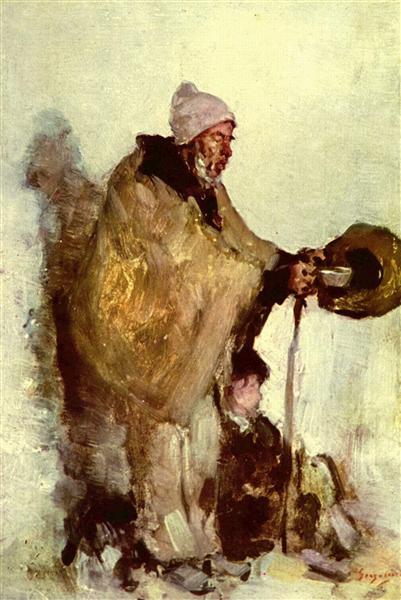Description
The painting "Breton Mendigo" (Breton Beggar) by Nicolae Grigorescu is erected as a clear example of the merger of humanity and naturalism that characterizes the work of this important Romanian painter of the nineteenth century. Belonging to the realistic current, Grigorescu captures in this work a scene of everyday life that goes beyond mere representation, inviting the viewer to an intimate reflection on the human condition and the social reality of his time.
In the center of painting, There is a middle -aged man, a beggar whose presence is both worthy and bleak. This figure is dressed in a worn coat, whose coloration and texture are perfectly amalgamated with the environment and dusty floor. The expression on his face, full of sadness and resignation, becomes a vehicle to convey a deep sense of empathy towards those who suffer in marginalization. The artist manages to highlight not only the physical appearance of his character, but also his emotional state through thorough nuances in clothing and posture, which suggest a personal story after the lost look.
The composition of the work is deployed through a careful disposition of elements that give a narrative framework to the scene. The beggar's figure is placed to the side, which allows the viewer to know the rural environment in which it is located. This Breton landscape, represented with soft hills and simple vegetation, reflects the painter's connection with the reality of the French countryside, a recurring theme in its career after settling in France. The light that bathes the scene, soft and diffuse, creates a melancholic atmosphere that resonates with the state of the character, and at the same time highlights the warmth of man's skin tone, who transmits an inherent vulnerability.
Grigorescu, influenced by its surroundings and the artistic currents of its time, including impressionism and realism, uses a palette that oscillates between earthly tones and colors off, echoing what could be a more stylized representation of poverty. However, it moves away from mere social criticism to achieve a more intimate approach, where the viewer not only observes, but feels summoned to participate in the experience of the represented subject. The work is in a context where the observation of the human being in its most humble conditions becomes an art form itself.
The choice of a beggar as the main subject is, without a doubt, a challenge to the usual perception of beauty in art. Through this, Grigorescu highlights the dignity that can be found in the serene sadness and daily suffering. It is a comment about life itself, in which individual stories are intertwined in the vast fabric of human existence. This approach would resonate with other contemporaries of the painter, who also explored issues of rural life and suffering, but the way Grigorescu presents it is particularly moving.
In short, "Breton beggar" is not only a representation of suffering, but a visual testimony of humanism that permeates the work of Nicolae Grigorescu. The interaction of color, shape and emotion in this painting makes the viewer not only look, but reflect, empathize and, ultimately, recognize shared humanity that unites beings of all social classes. In this sense, the work is a classic of realism, a lasting reminder of the nuances of life and the ability of art to be a vehicle for reflection and social transformation.
KUADROS ©, a famous paint on your wall.
Hand-made oil painting reproductions, with the quality of professional artists and the distinctive seal of KUADROS ©.
Art reproduction service with satisfaction guarantee. If you are not completely satisfied with the replica of your painting, we refund your money 100%.

